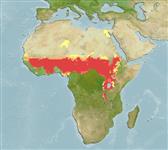Classification / Names
Common names from other countries
Main reference
Size / Weight / Age
Max length : 60.0 cm SL male/unsexed; (Ref. 4967); max. published weight: 4.3 kg (Ref. 40637); max. reported age: 9 years (Ref. 164)
Length at first maturity
Lm 18.6, range 6 - 28 cm
Environment
Freshwater; brackish; benthopelagic; potamodromous (Ref. 51243); depth range 0 - 20 m (Ref. 32849), usually ? - 20 m (Ref. 34290)
Climate / Range
Tropical; 14°C - 33°C (Ref. 3), preferred ?; 32°N - 5°S, 17°W - 38°E
Distribution
Africa: naturally occurring in coastal rivers of Israel (Ref. 5166), Nile basin (including lake Albert, Edward and Tana), Jebel Marra, Lake Kivu, Lake Tanganyika, Awash River, various Ethiopian lakes, Omo River system, Lake Turkana, Suguta River and Lake Baringo (Ref. 2). In West Africa natural distribution covers the basins of the Senegal, Gambia, Volta, Niger, Benue and Chad, with introduced specimens reported from various coastal basins (Ref. 53405). Widely introduced for aquaculture, with many existing strains. Several countries report adverse ecological impact after introduction. The following subspecies were previously recognized: Oreochromis niloticus baringoensis, Oreochromis niloticus cancellatus, Oreochromis niloticus eduardianus, Oreochromis niloticus filoa, Oreochromis niloticus niloticus, Oreochromis niloticus sugutae, Oreohromis niloticus tana and Oreohromis niloticus vulcani.
Countries | FAO areas | Ecosystems | Occurrences | Introductions
Short description
Dorsal
spines
(total): 15 - 18;
Dorsal
soft rays
(total): 11-13;
Anal
spines: 3;
Anal
soft rays: 9 - 11;
Vertebrae: 30 - 32. Diagnosis: jaws of mature male not greatly enlarged (length of lower jaw 29-37 % of head length); genital papilla of breeding male not tassellated (Ref. 2). Most distinguishing characteristic is the presence of regular vertical stripes throughout depth of caudal fin (Ref. 4967, 53405).
IUCN Red List Status (Ref. 115185)
Threat to humans
Potential pest
Human uses
Fisheries: highly commercial; aquaculture: commercial
Tools
Special reports
Download XML
Internet sources
Estimates of some properties based on models
Phylogenetic diversity index
PD50 = 0.5000 many relatives (e.g. carps) 0.5 - 2.0 few relatives (e.g. lungfishes)
Trophic Level
2.0 ±0.0 se; Based on diet studies.
Resilience
Medium, minimum population doubling time 1.4 - 4.4 years (K=0.14-0.41; tm=1-2; tmax=9; Fec < 1,000)
Vulnerability
Low to moderate vulnerability (30 of 100)
Price category
